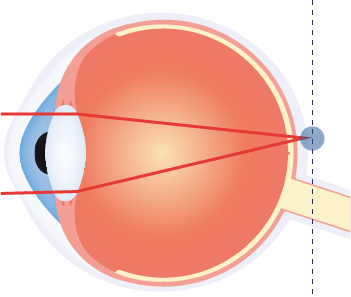


Correcting refractive errors, managing presbyopia, and addressing vision problems such as hyperopia (farsightedness), myopia (nearsightedness), and astigmatism.
Refractive error is a very common vision problem. The cornea and lens at the front of the eye focus the light coming into the eye and project it accurately onto the retina, forming a clear image. When the eye develops at different lengths, the light is not properly focused on the retina and the image is blurred, leading to reduced and incomplete vision and various refractive error conditions, such as myopia, hyperopia, presbyopia and astigmatism.
Many factors contribute to the development of refractive errors, including both genetic and environmental influences. For example, improper visual habits may cause the eyeball to elongate, leading to myopia. Individuals with a family history of refractive errors also have a higher likelihood of developing the condition. Common correction methods for astigmatism, myopia, and hyperopia, as well as management of presbyopia, include wearing glasses or contact lenses, intraocular lens implantation, and laser vision correction surgery.
Types of Refractive Error


Myopia (Short-sightedness)
Myopia is when the eyeball is too long or the lens is too thick, which affects the ability to focus and allows light to fall in front of the retina, causing the eye to see blurred images in the distance, while close ones are clearly visible. This is where concave lenses are required to correct, pushing the focus of the light towards the retina to improve the condition. Genetic factor and and excessive near work e.g. looking at electronic devices for prolonged duration can cause myopia progression in a growing eyeball.

Astigmatism
Astigmatism is chiefly caused by the irregular cornea, the vertical curvature of which is different from the horizontal one, resulting in a deviation of refraction. As a result, the light is not accurately focused on the retina. Objects indeed look blurry, making it harder for patients to see clearly. Prolonged concentration could lead to eye strain. Most astigmatic defects are congenital or inherited.

Hyperopia (Long-sightedness)
A long-sighted or hyperopic eye is usually caused by the fact that the eye is naturally too short and the light entering the eye is focused behind the retina, making it appear blurred when looking at near objects, but not when seeing things afar. At a young age, the ciliary muscles are strong enough to counteract mild hyperopia, so one can still see things more clearly from a distance. The ciliary muscle, however, degenerates with age, and gradually distant and near objects look blurry. Yet most hyperopic cases are congenital and common in children under six years old as children's eyes will grow and then long-sightedness will diminish.

Presbyopia
Presbyopia is due to gradual hardening of the lens, reduced elasticity and slow degeneration of the ciliary muscle, resulting in a weakening of the eye's ability to adjust to near focus and blurred vision at close range. The condition usually gets worse with age and starts to appear after the age of 40 to 45.
Symptoms of Refractive Error

Blurred or hazy vision

Headache and eye strain

Reading difficulty

Double vision

Halos around bright lights
Caution
If these symptoms are not corrected, they may affect your daily life. Consult an ophthalmologist or optometrist immediately.
Astigmatism, farsightedness and myopia correction methods

Should only be carried out by a qualified- eye specialist.After an eye examination by a professional ophthalmologist or optometrist, the following correction methods are required:

Wear glasses
Different types of lenses are available on the market and should be fitted according to different vision conditions:

Contact lenses
There are also different types of contact lenses and lenses with the right corrective features:

Intraocular lens replacement surgery
The principle involves using a minimally invasive technique to remove the natural lens and implant a suitable intraocular lens (IOL) inside the eye, thereby restoring clear, high‑definition vision. The procedure offers fast recovery, accurate results, and preserves the natural cornea while also preventing cataract formation. It is suitable for correcting high myopia and hyperopia, astigmatism, as well as managing presbyopia.

Laser vision correction surgery
SMILEIt is one of the laser vision correction surgeries and a new generation of vision correction technology, and has been certified by the US FDA.Carl Zeiss VisuMaxSMILE uses the Carl Zeiss VisuMax femtosecond laser system. Doctors can use this technology to improve patients' vision problems such as myopia and astigmatism. It is safer than traditional LASIK laser vision correction, and its speed and quality are also improved. SMILE technology is suitable for myopia correction, improvement of astigmatism and presbyopia correction, etc.

